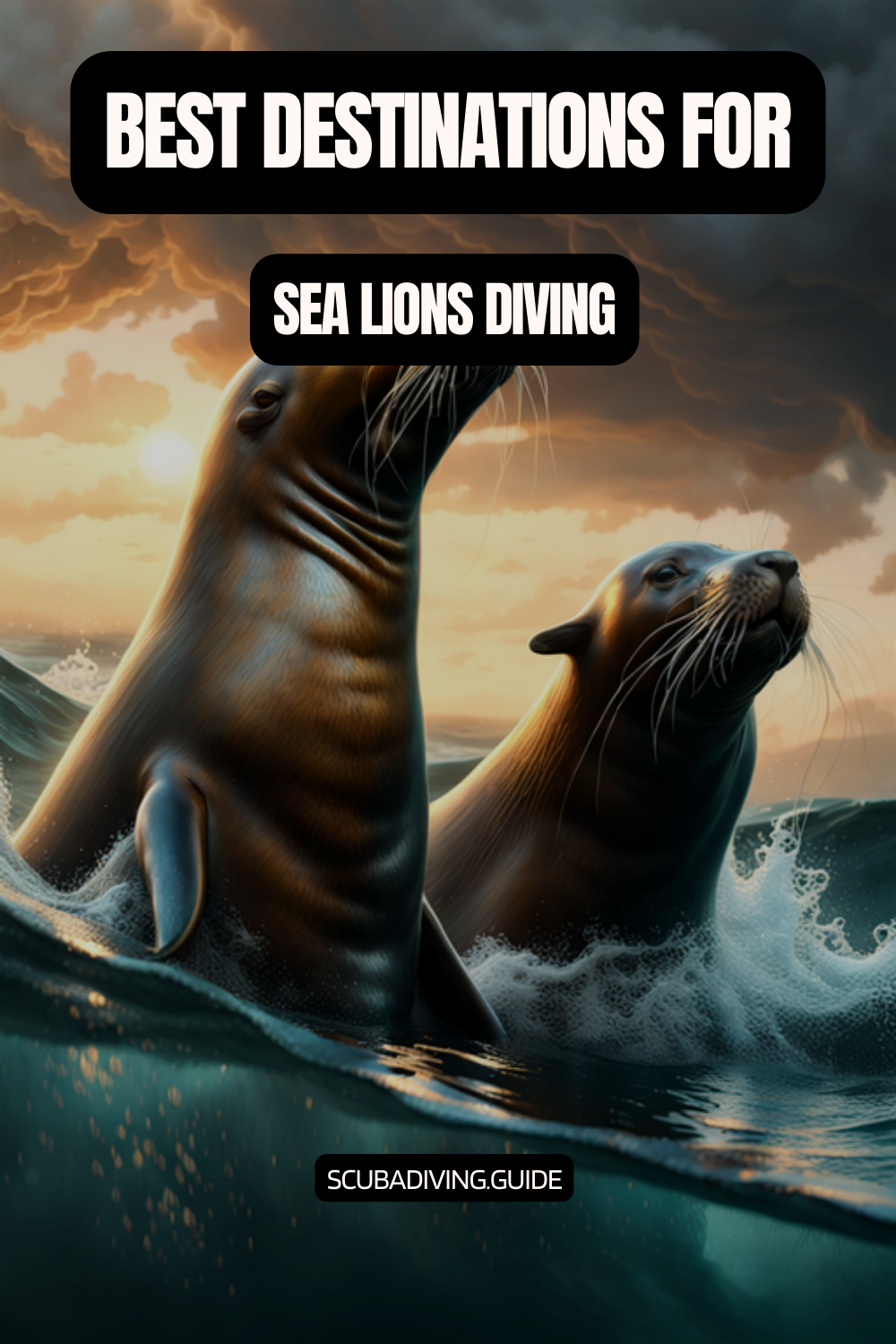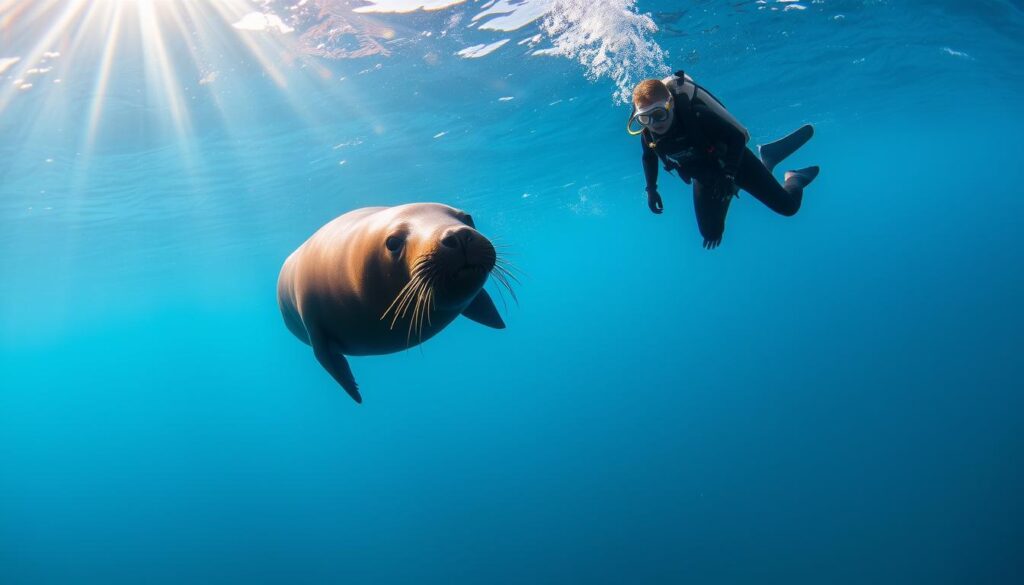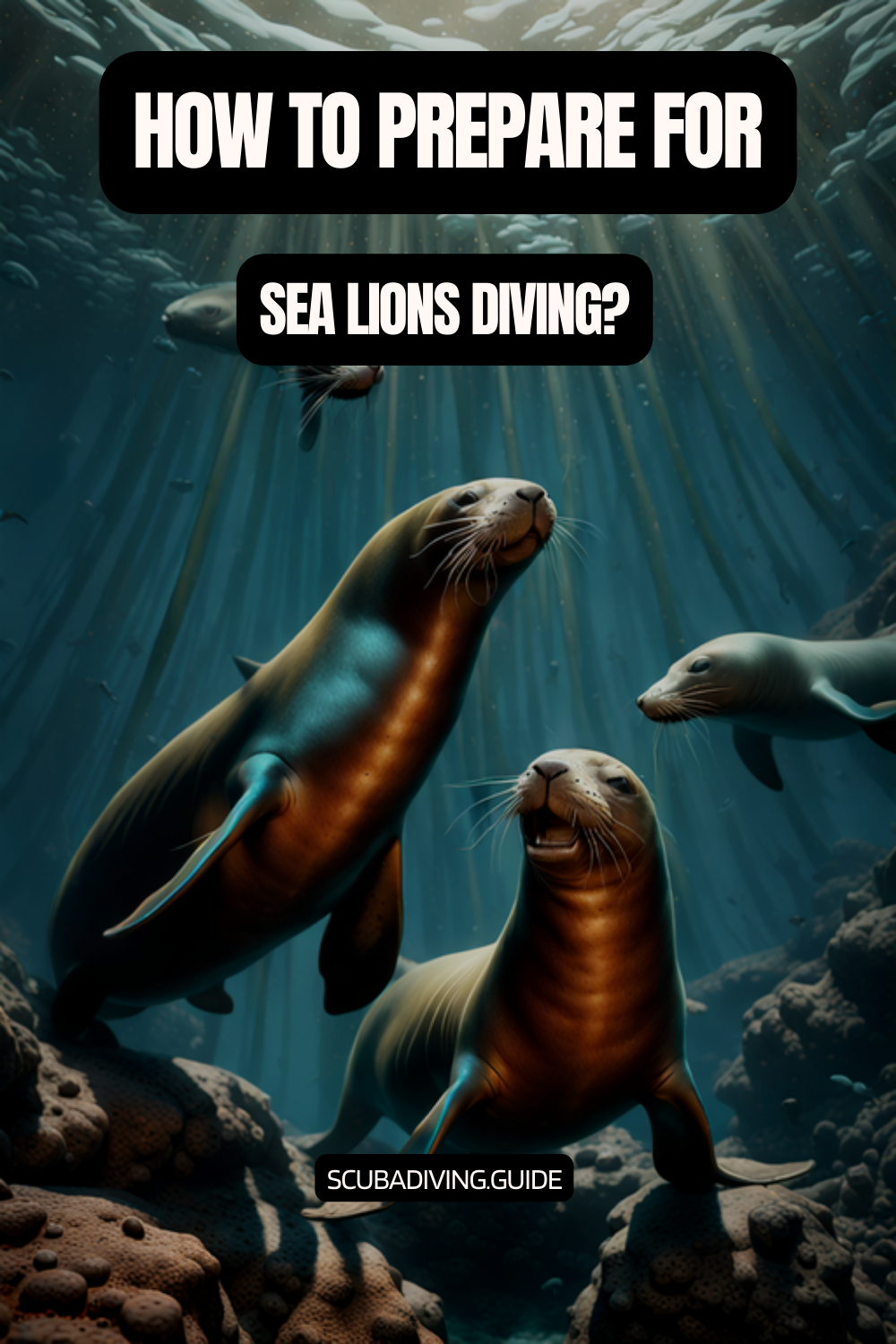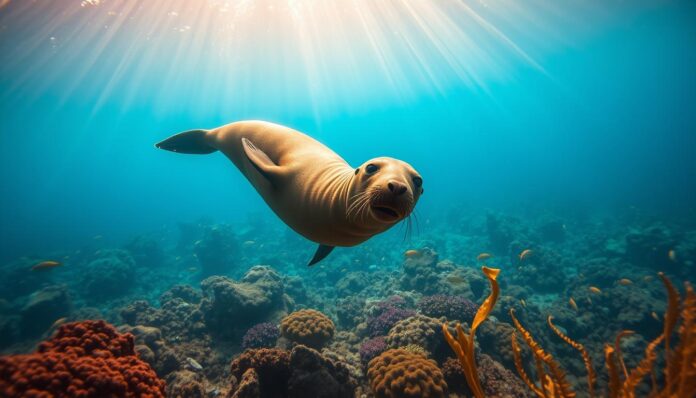Did you know La Paz, Baja California Sur, is a rare spot for swimming with sea lions? These amazing marine animals give divers a unique underwater experience. It turns a simple dive into an unforgettable adventure.
Scuba diving with sea lions is more than just a dive. It’s a deep dive into the Sea of Cortez’s vibrant marine world. The sea lion colony at Los Islotes is the biggest in this area. It offers divers amazing chances for sea lion encounters.
Imagine diving into clear waters, surrounded by playful sea lions. They dance and glide with grace. These experiences happen from October to May. It’s eight months of excitement and wonder.
Key Takeaways – Diving with Sea Lions
- La Paz offers unique scuba diving with sea lions experiences
- Sea lion encounters are possible from October to May
- Tours are limited to small groups of 6-8 people
- Basic open water certification is typically required
- Dive experiences include multiple marine life interactions
Understanding Sea Lions and Their Habitats
Sea lions are amazing marine mammals that fascinate divers and ocean lovers everywhere. They live in both the sea and coastal areas. This makes them perfect for California sea lion dives and exploring underwater.
Sea lions belong to the Otariidae family, which means “little ears” in science. They are known for their unique traits and ability to live in different ocean environments.
What Are Sea Lions?
Sea lions are pinnipeds with special features that make them stand out. They are part of a group of 33 pinniped species. Their adaptations allow them to do incredible things underwater.
- Can swim at burst speeds up to 25 mph
- Typical cruising speed around 11 mph
- Average lifespan of 20 years
- Exceptional hearing capabilities up to 70,000 Hz
Common Species of Sea Lions
When diving, you might see different sea lion species. The most well-known include:
| Species | Typical Weight | Habitat Range |
|---|---|---|
| California Sea Lion | 200-800 pounds | Vancouver Island to Mexico |
| Galapagos Sea Lion | 110-550 pounds | Galapagos Islands |
| Australian Sea Lion | 220-660 pounds | Southern Australian Coastline |
Where Do Sea Lions Live?
Sea lions live in various marine ecosystems across the Pacific Ocean. California sea lion dives let you see their homes. These include rocky coasts, remote islands, and temperate seas.
“Sea lions represent the incredible adaptability of marine mammals, thriving in environments that challenge human survival.” – Marine Biology Research Institute
They can dive to depths of 450 to 900 feet. This makes them great subjects for underwater study and interaction.
The Best Locations for Sea Lion Diving
Diving with sea lions is an amazing underwater adventure. It connects us with these playful marine mammals. The world has many incredible places where you can swim with sea lions and make memories that last a lifetime.
Top Dive Spots for Sea Lion Encounters
- Asia:
- Sea of Cortez, Mexico: The Sea of Cortez is home to one of the largest populations of California sea lions. Dive sites like Los Islotes near La Paz offer exceptional encounters with playful sea lions in crystal-clear waters.
- Galapagos Islands, Ecuador: Known for their unique biodiversity, the Galapagos Islands provide opportunities to dive alongside sea lions. Be enchanted by their underwater acrobatics as you explore the rich marine life of this iconic archipelago.
- Africa:
- Cape fur seal colonies, South Africa: Along the coastal areas of South Africa, diving with Cape fur seals is an exhilarating experience. Encounter these energetic and playful creatures in locations such as Cape Town, Port Elizabeth, or Hout Bay.
- Caribbean:
- Los Roques, Venezuela: The pristine coral reefs of Los Roques are home to thriving populations of southern sea lions. Enjoy close encounters with these inquisitive creatures while exploring the vibrant underwater world of the Caribbean.
- Islas Revillagigedo, Mexico: This remote archipelago, also known as the Socorro Islands, offers incredible diving opportunities with giant Pacific manta rays and the chance to interact with playful sea lions in their natural habitat.
- Central America:
- Islas de la Bahía, Honduras: The Bay Islands of Honduras, including Roatán, Utila, and Guanaja, offer diving experiences with both reef ecosystems and encounters with sea lions. Explore sites like Cayos Cochinos for memorable underwater encounters.
- Islas Ballestas, Peru: Located off the Pacific coast of Peru, the Islas Ballestas are home to colonies of South American sea lions. Dive into the rich waters around these islands to observe these magnificent creatures up close.
- Europe:
- Isles of Scilly, United Kingdom: The Isles of Scilly, situated off the southwestern coast of England, provide opportunities for encounters with Atlantic grey seals, creating unique and memorable diving experiences.
- Farne Islands, United Kingdom: The Farne Islands, located off the northeast coast of England, are known for their population of Atlantic grey seals. Dive into the chilly waters to observe and interact with these charismatic marine mammals.
- Oceania:
- Port Lincoln, Australia: Port Lincoln in South Australia is renowned for its diving experiences with Australian sea lions. Dive sites like Hopkins Island offer encounters with these playful creatures in a stunning underwater setting.
- New Zealand: Various locations around New Zealand, such as the Poor Knights Islands and the Marlborough Sounds, provide opportunities for diving alongside New Zealand fur seals. Discover the remarkable marine life and rugged coastlines of this captivating country.
- North America:
- Channel Islands, California, USA: The Channel Islands National Park, located off the coast of Southern California, offers exceptional diving encounters with California sea lions. Explore sites like San Miguel Island or Santa Barbara Island for unforgettable interactions.
- Vancouver Island, Canada: Along the shores of Vancouver Island in British Columbia, you can find diving opportunities with Steller sea lions. Dive sites like Hornby Island or Race Rocks Ecological Reserve provide a chance to witness these majestic creatures in their natural habitat.
- South America:
- Islas Malvinas (Falkland Islands): The Falkland Islands are home to large colonies of South American sea lions. Dive into the cold, nutrient-rich waters surrounding the islands for an unforgettable encounter with these remarkable marine mammals.
- Punta Loma, Argentina: Located near Puerto Madryn, Punta Loma is a natural reserve where you can dive with South American sea lions. Observe their playful behavior while exploring the diverse marine life of the region.
These destinations offer remarkable opportunities to dive alongside sea lions and create unforgettable memories. Each region provides a unique setting and diving experience, allowing you to appreciate the beauty and diversity of these captivating marine mammals in different parts of the world.

Local Regulations and Conservation
When diving with sea lions, it’s important to dive responsibly. Many places have rules to protect these marine animals and their homes.
“Respect the ocean and its inhabitants. Every dive is a privilege, not a right.” – Marine Conservation Expert
The Galapagos Islands, a UNESCO World Heritage site, show how to protect sea lions. Divers must keep a safe distance and follow local rules to help protect sea lion populations.
- Maintain a safe distance from sea lions
- Never touch or feed marine wildlife
- Use eco-friendly diving operators
- Support local conservation programs
What to Expect During a Sea Lion Dive
Diving with sea lions is an exciting adventure. These marine mammals are playful and curious. They create unforgettable experiences for divers worldwide.

Get ready for an amazing underwater journey. Sea lions might come close, showing off their agility and social nature.
A Typical Diving Experience
Here’s what you might see on a sea lion dive:
- Playful juveniles checking out divers with great interest
- Sea lions moving fast, up to 30 knots
- They might interact near rocks or underwater features
Interactions with Sea Lions
“Sea lions are like underwater acrobats, turning every dive into a magical performance.” – Marine Wildlife Expert
Sea lion interactions vary by location. In places like Los Islotes, Mexico, or the Channel Islands, you might see:
- Pups playing with sea stars and shells
- Male sea lions showing off their territory
- Whole colonies swimming by
Safety Precautions to Consider
Sea lion encounters are thrilling, but keep a safe distance. Experienced divers suggest:
- Avoid direct eye contact
- Move slowly and predictably
- Respect their habitat
- Follow local diving rules
Remember, sea lions are wild animals. Observe, appreciate, but never touch or feed them.
Essential Gear for Scuba Diving with Sea Lions
Getting ready for scuba diving with sea lions means picking the right gear. The right equipment makes your dive safe and memorable. It also helps you capture amazing photos of sea lions.
Recommended Diving Equipment
Every diver needs basic gear for a great sea lion dive. Here’s what you should have:
- Scuba mask with clear, wide-angle visibility
- Buoyancy compensation device (BCD)
- Dive computer with depth and time tracking
- Reliable scuba regulator with octopus setup
- Dive weights for proper underwater balance
Wet Suits and Thermal Protection
Choosing the right thermal protection is key for a comfortable dive. Water temperatures can vary a lot between places. Here are some suit options:
- 2.5mm suits for warmer waters
- 5-7mm suits for cooler marine environments
- Dry suits for extremely cold conditions
“Your wetsuit is your second skin underwater – choose it wisely for maximum comfort and protection.”
Underwater Cameras for Capturing Moments
Sea lion photography needs special underwater camera gear. Look for these features:
- Waterproof housing
- Wide-angle lens for marine environments
- Fast shutter speed to capture playful sea lion movements
- Compact design for easy underwater maneuverability
Having your own gear boosts dive confidence. It makes you more familiar with your equipment. While rentals are available, owning your gear can make your sea lion diving better.
Preparing for Your Dive Trip
Adventure travel fans eager to dive with sea lions must prepare well. Planning your dive trip needs careful thought and detail. The right steps can make your dive unforgettable.

Finding the best dive operator is key for a great sea lion dive. Not all operators are the same. Your choice affects your safety and fun.
Choosing the Right Dive Operator
- Look for operators known for marine conservation
- Check their certifications and safety rules
- Read what other customers say
- Make sure guides know how to interact with sea lions
Booking in Advance
Popular spots for diving with sea lions fill up fast. Booking early helps you get the dates you want and enjoy your trip more.
| Booking Consideration | Recommended Action |
|---|---|
| Advance Notice | 3-6 months before planned dive |
| Peak Season | Book 6-9 months ahead |
| Group Size | Limit to 4-6 divers per guide |
Travel Tips for Divers
- Bring lightweight, easy-to-carry diving gear
- Carry extra parts for your gear
- Check airline rules for luggage
- Get travel insurance that covers diving
“Preparation is the key to an unforgettable underwater adventure with sea lions.”
By following these tips, divers can have a safe, exciting dive with sea lions. It will be an experience that respects the ocean and leaves lasting memories.
The Importance of Conservation Efforts
When we swim with sea lions, we must act responsibly. Conservation is key to protecting these amazing creatures and their homes.
Impact of Tourism on Sea Lion Populations
Tourism can affect sea lion habitats a lot. Marine encounters are thrilling, but they can disrupt natural behaviors if not managed right.
- Increased human presence can stress marine wildlife
- Unregulated interactions may alter sea lion behavior
- Repeated disturbances can impact breeding and feeding patterns
Supporting Local Conservation Programs
Protecting sea lions needs focused conservation efforts. Groups like NOAA Fisheries are helping by funding important work for endangered marine species.
| Conservation Focus | Key Statistics |
|---|---|
| Galapagos Sea Lion Protection | Most abundant marine mammal in Galapagos Archipelago |
| Plastic Waste Management | 1 million tonnes of plastic leak into Pacific coastline annually |
| Endangered Species Monitoring | NOAA funding field response efforts in 2024 |
Responsible Diving Practices
Divers can help marine life by diving responsibly. Ethical marine life interactions mean understanding and respecting wildlife’s space.
“Our actions today determine the marine ecosystems of tomorrow.”
- Maintain safe distance from sea lions
- Avoid touching or feeding wildlife
- Follow local guidelines and regulations
- Minimize underwater noise and disruption
By diving responsibly, we can safeguard these incredible marine mammals. We also get to enjoy amazing underwater adventures.
Diving Techniques for Sea Lion Encounters
Exploring the underwater world with sea lions needs special skills and knowledge. Scuba diving with them offers a unique marine adventure. It requires careful technique and respect for these amazing marine mammals.
Approaching Sea Lions Safely
When snorkeling with sea lions, it’s important to be calm and not scary. Sea lions are curious but can get scared easily. Here are some safety tips:
- Move slowly and predictably underwater
- Allow sea lions to initiate contact
- Maintain a respectful distance
- Avoid direct eye contact
Free Diving vs. Scuba Diving
Free diving and scuba diving both have their own perks when meeting sea lions. Each has its own benefits:
| Free Diving | Scuba Diving |
|---|---|
| More natural movement | Longer underwater time |
| Less equipment interference | Better depth control |
| Closer to sea lion behavior | Enhanced safety features |
Utilizing Buoyancy Control
The Avelo system changes how divers control buoyancy underwater. This advanced method lets divers move freely with sea lions. It keeps them neutral in the water, allowing for better interaction.
“Mastering buoyancy is the key to an unforgettable sea lion diving experience.” – Marine Biology Expert
Sea lions can swim fast, up to 40 km/h, and dive deep, 180 meters. It’s important to respect their home and enjoy this amazing underwater adventure.
Photographic Opportunities Underwater
Sea lion photography needs skill, patience, and knowledge of underwater wildlife viewing. These marine mammals are perfect for capturing their playful and dynamic behaviors in their natural home.
Photographers face unique challenges when shooting sea lions underwater. Their fast movements and unpredictable actions require special techniques and gear.
Essential Tips for Stunning Sea Lion Images
- Use a fisheye lens for close-proximity shots
- Select fast shutter speeds (minimum 1/125 second)
- Adjust camera settings for low-light conditions
- Maintain safe distance while capturing images
Recommended Camera Settings
| Environment | Recommended Settings |
|---|---|
| Clear Blue Water | 1/200 sec, F11, ISO 320 |
| Turbid Waters | 1/125 sec, Strobes Forward |
| Movement Capture | 1/4 – 1/15 sec for blur effect |
Ethical Photography Practices
Responsible underwater wildlife viewing means respecting sea lion habitats. Never disturb their natural behaviors or get too close. Photographers should always put animal welfare first, even if it means missing the perfect shot.
“Capture the moment, but protect the marine environment.” – Professional Wildlife Photographer
The eastern Pacific is great for sea lion photography. Places like British Columbia, California, Galapagos, and Mexico are perfect. The best time is usually October and early November, when sea lion pups are most active and playful.
Health and Safety Considerations
For those who love adventure travel, scuba diving with sea lions is thrilling. But, safety and being prepared are key. Knowing about dive physiology and risks can make the experience safe and memorable.

Understanding Dive Physiology
Diving physiology is vital for safe marine wildlife interactions. When diving with sea lions, it’s important to know how pressure affects us at different depths. Key points include:
- Managing nitrogen absorption
- Controlling breathing rates
- Monitoring depth and time underwater
Dealing with Potential Risks
Sea lion encounters can be challenging for divers. Risks include:
- Unpredictable animal behavior
- Challenging ocean conditions
- Equipment malfunction
“Safety is not an accident, but a deliberate choice in underwater environments.” – Marine Safety Expert
Emergency Procedures While Diving
Being ready can prevent serious issues. Divers should know how to:
- Rapidly fix equipment
- Follow emergency ascent protocols
- Provide first aid for marine injuries
| Safety Metric | Recommended Standard |
|---|---|
| Dive Depth | 5-10 meters |
| Dive Duration | 30-40 minutes |
| Certification Required | PADI Certification |
| Distance from Sea Lions | Maintain respectful distance |
Remember, responsible diving ensures both human and marine life safety during these extraordinary underwater adventures.
Personal Experiences and Testimonials
Sea lion encounters turn ordinary dives into unforgettable adventures. Divers around the world say swimming with these playful creatures is a memory-maker. It changes how we see wildlife interactions.
Experienced divers share amazing stories about their sea lion encounters. They talk about the sea lions’ intelligence and curiosity. In the Sea of Cortez, divers say sea lions come close in just 10 minutes, showing off their social skills.
Memorable Dive Stories
Marine photographers find sea lion encounters thrilling and unpredictable. A diver from California told of being surrounded by 15 sea lions near San Francisco Island. It was an underwater show like no other.
These encounters need careful handling to keep both divers and sea lions safe. It’s all about respect and understanding.
Tips from Experienced Divers
Before diving, learn about sea lion behavior. Don’t stare them down, as it might seem like a challenge. Also, avoid using shiny underwater cameras to prevent unwanted attention.
Wear neutral-colored diving gear and move calmly. This helps you have better interactions with these fascinating creatures.
Why You Should Try Diving with Sea Lions
Diving with sea lions is a unique chance to connect with marine life. The mix of playful sea lions, beautiful underwater scenes, and thrilling encounters makes it a must-do for divers.
Common Marine Species Found Alongside Sea Lions
Diving with sea lions not only provides the opportunity to interact with these charismatic marine mammals but also offers encounters with a diverse array of marine species. These interactions can enrich your diving experience, showcasing the interconnectedness of life in the ocean. Let’s explore some of the common marine species often found alongside sea lions.
- Fish: Sea lions often share their underwater habitat with an abundance of fish species. Schools of colorful tropical fish, such as damselfish, angelfish, and surgeonfish, add vibrant splashes of color to the underwater scenery. Larger fish like jacks, groupers, and snappers can be spotted patrolling the reefs or congregating in feeding areas. The presence of these fish attracts the attention of sea lions, creating dynamic underwater interactions.
- Rays: Diving alongside sea lions may offer opportunities to encounter graceful rays gliding through the water. From the majestic eagle rays with their impressive wingspan to the elusive and camouflaged stingrays, these gentle creatures often inhabit the same coastal areas as sea lions. Witnessing their elegant movements and observing their feeding or resting behaviors can be a captivating sight.
- Sharks: While encounters with sharks are less common, diving with sea lions can occasionally provide glimpses of these apex predators. Species such as reef sharks, nurse sharks, or even the majestic hammerhead sharks may frequent the same areas as sea lions. Observing their sleek forms and witnessing their role as top predators can evoke awe and admiration.
- Sea Turtles: The presence of sea turtles adds a touch of tranquility to the underwater environment. These ancient creatures, such as green turtles, hawksbill turtles, or loggerhead turtles, may be seen gracefully gliding through the water or resting on the seafloor. Witnessing their gentle movements and observing their interactions with the surrounding habitat can evoke a sense of wonder and appreciation.
- Cephalopods: From the elusive octopus to the mesmerizing cuttlefish and the intriguing squid, cephalopods are fascinating marine creatures often encountered during dives with sea lions. Their ability to change color and shape, along with their intelligent behaviors, make them captivating subjects of observation. Witnessing their camouflaging techniques or observing their courtship rituals can be a highlight of your underwater experience.
- Marine Invertebrates: Alongside sea lions, you’ll often find an incredible diversity of marine invertebrates. Colorful corals, delicate anemones, and intricate sponges decorate the underwater landscape, providing habitat and shelter for various small organisms. Keep an eye out for colorful nudibranchs, tiny seahorses, or fascinating crustaceans like shrimp or crabs, which inhabit the nooks and crevices of the reef.
Encountering these diverse marine species alongside sea lions adds depth and richness to your diving experience. Observing the intricate relationships between different organisms and witnessing the balance of marine ecosystems enhances your appreciation for the interconnectedness of life beneath the surface.
Remember, while interacting with these species, it’s important to maintain a respectful distance, avoid any disruptive behavior, and prioritize the well-being of the marine environment. By embracing these encounters with care and curiosity, you can deepen your understanding of the intricate web of life in the ocean.
FAQ – Diving with Sea Lions
Are sea lions dangerous to divers?
Sea lions are usually curious and playful. But, they can get defensive if they feel threatened. Most dives are safe if divers follow guidelines, keep a distance, and avoid sudden moves.
Male sea lions during breeding season can be more territorial. It’s important to stay calm and follow your dive guide’s instructions.
What is the best time of year to dive with sea lions?
The best time to dive with sea lions varies by location. In the Galapagos Islands, the best time is from June to November. For California sea lions, the peak season is between August and March.
In Mexico’s La Paz, the prime months are from November to May. Always check local conditions and consult with experienced dive operators for the most accurate seasonal recommendations.
Do I need special certification to dive with sea lions?
You don’t need a special certification just for sea lion diving. But, most operators recommend an Open Water Diver certification at minimum. Advanced certifications like Advanced Open Water can be beneficial, too.
Some operators may require additional experience with cold water or surge conditions.
What equipment do I need for sea lion diving?
You’ll need a wetsuit, mask, fins, and standard scuba gear. For colder locations, a 7mm wetsuit or dry suit is recommended. Underwater cameras are optional but highly recommended for capturing memorable encounters.
Always ensure your gear is well-maintained and appropriate for the specific diving conditions.
How close can I get to sea lions underwater?
Keep a minimum distance of 15-20 feet from sea lions underwater. Never chase or corner them, as this can cause stress and aggressive behavior. Experienced divers recommend staying calm, moving slowly, and letting sea lions initiate interactions if they choose to do so.
Are there any conservation concerns I should be aware of?
Yes, responsible diving is key. Choose operators committed to marine conservation. Minimize your environmental impact and never touch or feed sea lions.
Many populations face threats from climate change, overfishing, and habitat destruction. By diving responsibly and supporting local conservation efforts, you can help protect these incredible marine mammals.
Can beginners dive with sea lions?
While beginners can dive with sea lions, it’s recommended to have some prior diving experience. Strong swimming skills, good buoyancy control, and comfort in varied underwater conditions are essential.
Many dive operators offer guided experiences suitable for intermediate divers, ensuring both diver safety and positive wildlife interactions.
What makes sea lion diving unique?
Sea lion diving offers an extraordinary underwater experience. The animals’ incredible playfulness and curiosity make it unique. Unlike many marine encounters, sea lions often actively engage with divers.
They swim close, perform underwater acrobatics, and display remarkable intelligence. It’s a truly interactive wildlife experience that differs from passive marine observations.
